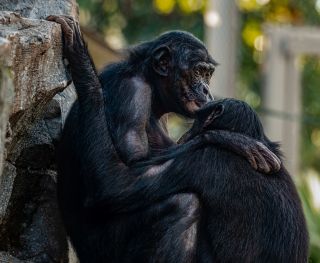Laughter
The Hidden Link Connecting Human and Chimpanzee Laughter
Our laughter may sound different, but what about its message and meaning?
Updated June 30, 2023 Reviewed by Gary Drevitch
Key points
- Great apes, including the both chimpanzee species, often use laughter-like vocalizations during play.
- A novel theory of laughter can help us determine if a chimp’s laughter serves the same purpose as ours.
- Like humans, chimps use physical humor (e.g., tickling) to highlight vulnerabilities and affirm social bonds.

Scholars have long wondered whether humans are unique in their use of laughter. There is little doubt that all of our close genetic relatives—chimps, gorillas, and orangutans—use some form of laughter-like vocalization in certain social interactions. The real question is whether the expression employed by nonhuman apes conveys the same information and serves the same function. Does it affirm mutual vulnerability precisely the way ours does?
Let’s take a look, beginning with the common chimpanzee (Pan troglodytes) and the pygmy chimpanzee or “bonobo” (Pan paniscus)
Our kindred spirits
Differences in the genetic makeup between humans and both chimpanzee species indicate a relatively recent divergence in our evolutionary paths, one occurring approximately 6 million years ago (Tattersall, 1998). While our forest “cousins” inhabit comparable environments and look very similar to each other, genetically speaking, bonobos and common chimpanzees are only slightly more related to each other than each is to humans (Baily et al, 1992).
According to Low (2000), common chimpanzee groups continually vary in size and composition. Individuals organize themselves within formal dominance hierarchies, one for males and one for females, with females subordinate to the larger and more aggressive adult males. Males are highly territorial and attempt to acquire new foraging areas and females from rival neighboring bands. Within-group coalitions constantly fluctuate, necessitating frequent reinforcement of social bonds.
De Waal (1997) describes bonobo social structure as much less hierarchical, with stability based more on evolving coalitions. Males and females interact more as equals, especially when it comes to the acquisition of food resources, and males are much more reticent to use physical force. Bonobos seem to influence others by means of positive reinforcement, engaging in close physical contact between all members of a group.
Common chimpanzees have a wide range of vocalizations including barks, grunts, screams, and hoots. Bonobos are more vocal than chimps and have higher-pitched voices—more a and e sounds than u and o (de Waal, 1997). Both, however, have similar “play-face” expressions—mouth open, the upper lip covering the upper teeth, and the lower teeth exposed (de Waal, 1997; van Lawick-Goodall, 1971). De Waal notes their laughter is identical in structure, “the only sound virtually indistinguishable in the two species." During physical play, including chases, wrestling, play biting or hitting, and most especially tickling play, the mouth is opened in a relaxed expression, and coarse, guttural panting sounds are heard when partners tickle each other. Robert Provine (1996) describes it as a “breathy panting vocalization produced during each brief expiration [exhalation] and inspiration [inhalation]," whereas human laughter tends to involve choppy, relatively consistent vowel-like sounds (“ha-ha-ha” or “ho-ho-ho,” but not “ha-ho-ha-ho”) repeated on a succession of exhalations or inhalations, but rarely both.
Laughter in wild chimpanzees
Pioneering researcher Jane Goodall reported several incidents in which she observed wild chimpanzees expressing laughter-like vocalizations. Most instances involved young chimpanzees engaged in play, but adults also solicited and demonstrated this behavior:
Once Olly [an adult female], noticing that Gilka [an adolescent female] was having a tickling game with Rodolf [an old male], quickly approached and with worried pant-grunts laid her hand placatingly on the big male’s back. Rodolf, who did not need placating, continued to play, lying on his side and heaving with quiet chimpanzee laughter as Gilka clambered up his large frame and play-bit his ticklish neck….Suddenly Rodolf turned to Olly and began tickling her in the neck with one hand while with his foot he continued to tickle Gilka. Olly’s face was a study. Her lips wobbled in agitation, her eyes stared, and her pant-grunts became positively hysterical. She pulled back, but Rodolf followed and tickled her again. For a few moments her long lips bunched themselves into the semblance of a play-face, and I detected a note of laughter in her frenzied grunts…. (1971).
The next narrative describes an encounter that followed by two hours one of the senior males’ brief but “savage” attack on Flo [the alpha female] for attempting to secure some fruit put out by the researchers—as far as a hungry male is concerned, an act of supreme insolence. Mike’s actions were interpreted as a peace gesture:
Mike sat up and leaned over Flo, tickling her neck and her ticklish groin until, protecting Flint [Flo’s infant son] with one hand and parrying Mike with the other, Flo started to shake with panting gasps of chimpanzee laughter. After a while she could stand it no more and rolled away from him. But she was roused, this ancient female with her stumps of teeth, and soon she was tickling Mike in the ribs with her bony fingers. Then it was Mike’s turn to laugh and reach to grab her hands and tickle her again himself (1971).

Laughter in a captive bonobo
Ape language researchers Sue Savage-Rumbaugh and Robert Ewin (1994) relate the reunion of Kanzi, who was learning to communicate with humans via computer symbols, and his mother, Matata, who was returning from another facility where she was paired for mating:
Kanzi leapt into Matata’s arms, and they screamed and hugged for fully five minutes, and then stepped back to gaze at each other in happiness. They then played like children, laughing all the time as only bonobos can. The laughter of a bonobo sounds like the laughter of someone who has laughed so hard that he has run out of air but can’t stop laughing anyway.
The link
With our understanding of laughter provided by The Mutual Vulnerability Theory, we can now forge the link between our laughter and that seen in both chimpanzees and bonobos. They are used for the same purpose and in similar contexts as ours, particularly among young children engaging in physical play, where feelings of vulnerability are clearly highlighted. By gently engaging with each other in mock attacks, members of each group build trust and strengthen critical social bonds.
This post was adapted from Chapter Seven of Why We Laugh: A New Understanding.
© John Charles Simon.
References
Bailey, W. J., K. Hayasaka, C. G. Skinner, S. Kehoe, L. C. Sien, J. L. Slighten and M. Goodman. (1992). Re-examination of the African Hominoid Trichotomy with Additional Sequences from the Primate {beta}-Globin Gene Cluster. Molecular Phylogenetics and Evolution 1 (2): 97 – 135.
de Waal, F. B. M. (1997). Bonobo: The Forgotten Ape. University of California Press.
Fouts, R. (1997). Next of Kin: What Chimpanzees Have Taught Me About Who We Are. New York: William Morrow and Company.
Low, B. S. (2000). Why Sex matters: A Darwinian Look at Human Behavior. Princeton, NJ: Princeton University Press.
Provine, R. R. (1996). Laughter. American Scientist 84: 38 – 44.
Savage-Rumbaugh, E. S. and R.Lewin. (1994). Kanzi: The Ape at the Brink of the Human Mind. New York: John Wiley and Sons.
Simon, J. C. (2008). Why We Laugh: A New Understanding. Starbrook Publishing.
Tattersall, I. (1998). Becoming Human: Evolution and Human Uniqueness. Orlando, FL: Harcourt Brace and Co.
van Lawick-Goodall, J. (1971). In the Shadow of Man. Boston: Houghton Mifflin Company.




